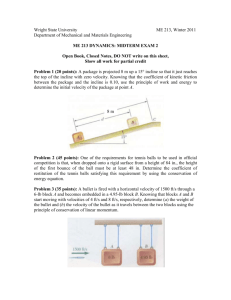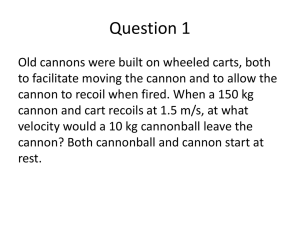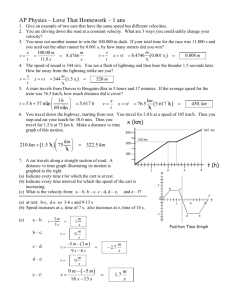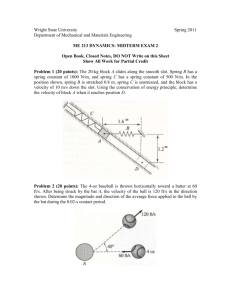Worksheet-ConservationOfMomentumQuestions
advertisement
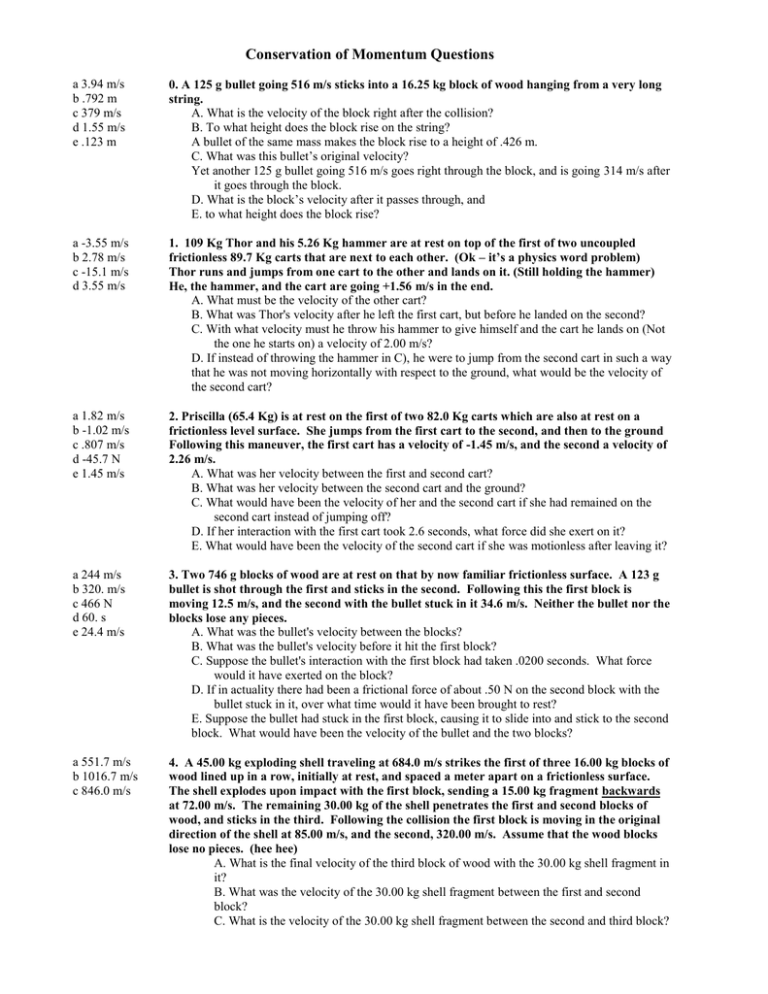
Conservation of Momentum Questions a 3.94 m/s b .792 m c 379 m/s d 1.55 m/s e .123 m 0. A 125 g bullet going 516 m/s sticks into a 16.25 kg block of wood hanging from a very long string. A. What is the velocity of the block right after the collision? B. To what height does the block rise on the string? A bullet of the same mass makes the block rise to a height of .426 m. C. What was this bullet’s original velocity? Yet another 125 g bullet going 516 m/s goes right through the block, and is going 314 m/s after it goes through the block. D. What is the block’s velocity after it passes through, and E. to what height does the block rise? a -3.55 m/s b 2.78 m/s c -15.1 m/s d 3.55 m/s 1. 109 Kg Thor and his 5.26 Kg hammer are at rest on top of the first of two uncoupled frictionless 89.7 Kg carts that are next to each other. (Ok – it’s a physics word problem) Thor runs and jumps from one cart to the other and lands on it. (Still holding the hammer) He, the hammer, and the cart are going +1.56 m/s in the end. A. What must be the velocity of the other cart? B. What was Thor's velocity after he left the first cart, but before he landed on the second? C. With what velocity must he throw his hammer to give himself and the cart he lands on (Not the one he starts on) a velocity of 2.00 m/s? D. If instead of throwing the hammer in C), he were to jump from the second cart in such a way that he was not moving horizontally with respect to the ground, what would be the velocity of the second cart? a 1.82 m/s b -1.02 m/s c .807 m/s d -45.7 N e 1.45 m/s 2. Priscilla (65.4 Kg) is at rest on the first of two 82.0 Kg carts which are also at rest on a frictionless level surface. She jumps from the first cart to the second, and then to the ground Following this maneuver, the first cart has a velocity of -1.45 m/s, and the second a velocity of 2.26 m/s. A. What was her velocity between the first and second cart? B. What was her velocity between the second cart and the ground? C. What would have been the velocity of her and the second cart if she had remained on the second cart instead of jumping off? D. If her interaction with the first cart took 2.6 seconds, what force did she exert on it? E. What would have been the velocity of the second cart if she was motionless after leaving it? a 244 m/s b 320. m/s c 466 N d 60. s e 24.4 m/s 3. Two 746 g blocks of wood are at rest on that by now familiar frictionless surface. A 123 g bullet is shot through the first and sticks in the second. Following this the first block is moving 12.5 m/s, and the second with the bullet stuck in it 34.6 m/s. Neither the bullet nor the blocks lose any pieces. A. What was the bullet's velocity between the blocks? B. What was the bullet's velocity before it hit the first block? C. Suppose the bullet's interaction with the first block had taken .0200 seconds. What force would it have exerted on the block? D. If in actuality there had been a frictional force of about .50 N on the second block with the bullet stuck in it, over what time would it have been brought to rest? E. Suppose the bullet had stuck in the first block, causing it to slide into and stick to the second block. What would have been the velocity of the bullet and the two blocks? a 551.7 m/s b 1016.7 m/s c 846.0 m/s 4. A 45.00 kg exploding shell traveling at 684.0 m/s strikes the first of three 16.00 kg blocks of wood lined up in a row, initially at rest, and spaced a meter apart on a frictionless surface. The shell explodes upon impact with the first block, sending a 15.00 kg fragment backwards at 72.00 m/s. The remaining 30.00 kg of the shell penetrates the first and second blocks of wood, and sticks in the third. Following the collision the first block is moving in the original direction of the shell at 85.00 m/s, and the second, 320.00 m/s. Assume that the wood blocks lose no pieces. (hee hee) A. What is the final velocity of the third block of wood with the 30.00 kg shell fragment in it? B. What was the velocity of the 30.00 kg shell fragment between the first and second block? C. What is the velocity of the 30.00 kg shell fragment between the second and third block? More Momentum Questions: 1. A 1200 Kg car going 13 m/s collides with a 4200 Kg truck at rest. Their bumpers lock. What is their speed afterwards? (2.89 m/s) 2. A 60.0 Kg person running 3.00 m/s East collides head on with a 100. Kg person running 2.00 m/s the other way. What is their final velocity if they stick together? (0.125 m/s West) 3. A 50. Kg ice skater at rest throws a 5.0 Kg shot put at a velocity of +3.5 m/s. What is the recoil velocity of the skater? (-0.35 m/s) 4. A 1200 Kg car going 15 m/s rear-ends with a 800. Kg car going 5.0 m/s in the same direction. Their bumpers lock. What is their speed afterwards? (11 m/s) 5. A 2000. Kg airplane going 45.0 m/s fires a 2.00 Kg shell forward at a speed of 1200. m/s. What is the final velocity of the plane? (Planes crashed because of this!) (43.8 m/s) 6. A 14.5 g bullet traveling 783 m/s horizontally strikes a 9.24 Kg block of wood at rest on a level frictionless table. The bullet goes through the block, but is traveling only 382 m/s in the same direction after the collision. What is the velocity of the block after the collision? (Assume the block loses no mass) (0.629 m/s) 7. Bumper car A (326 Kg) with velocity 3.7 m/s East collides with the rear of car B (536 Kg) which has a velocity of 2.4 m/s East. After the collision, car A has a velocity of 1.2 m/s to the West. What is the velocity of car B after the collision? (5.4 m/s East) 8. A 132.45 g bullet traveling at 386 m/s rips a hole through a 1.34 Kg block of wood at rest on some frictionless ice. The bullet is traveling 153 m/s following the collision, what is the speed of the block? (23.0 m/s) 9. A 153 gram bullet going 452 m/s goes through the first of two stationary 3.50 kg blocks of wood, and sticks in the second. After this, the first block is traveling at 6.50 m/s in the same direction. i. What speed are the second block and bullet going? (12.7 m/s) ii. What is the bullet’s velocity between the blocks? (303 m/s) 10. 60.0 kg Brennen is playing on two flatbed rail cars initially at rest. Car A has a mass of 560. kg and B 780. kg. He reaches a velocity of +5.20 m/s on A, before jumping to B where he slows to +3.40 m/s before jumping off the other end. The cars are uncoupled, and rest on a frictionless track: i. ii. iii. iv. What is the velocity of car A when he is in midair? (-0.557 m/s) What is the velocity of car B when he leaves it? (+0.138 m/s) What would have been the velocity of car B had he remained there, and not jumped off? (+0.371 m/s) What would the velocity of car B have been had he jumped off the back of it to give himself a velocity of zero? (+0.40 m/s)

